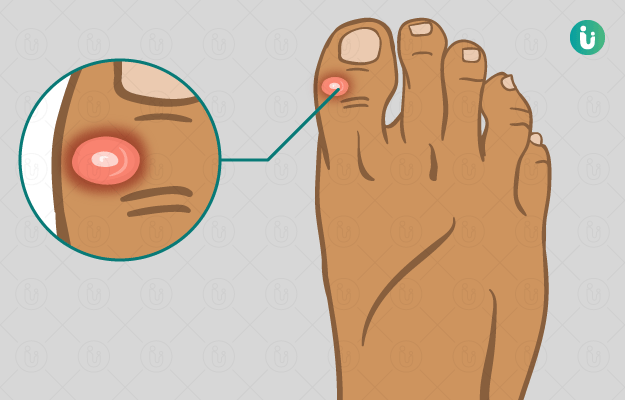What is a blister?
A blister is a collection of fluid in tiny sacs or spots on the surface (superficial layer) of the skin. Hands and feet are the most common areas on the body that are prone to blister formation. Blisters are usually filled with clear fluid (serum), blood or pus. Frequent irritation or friction damages the exposed area of skin and leads to collection of fluid, which protects the underlying tissue from further damage.
What are its main associated signs and symptoms?
Depending on the cause, different signs and symptoms are associated with blisters.
- Pain and redness are commonly associated with blisters (e.g. wrong fitting shoes, burns, injury, etc).
- Blisters with redness and peeling of skin occur due to burns, autoimmune diseases (epidermolysis bullosa).
- Fever is present along with blisters near the lips in case of viral infection (fever blister).
- Itching is associated with blisters in eczema, skin infection (impetigo).
- Skin turns white and shiny and is associated with numbness in frostbite blisters.
- Tanning with wrinkles on the skin is associated with blisters due to sunburn.
- Burning pain with a scab on blisters is present in shingles (herpes zoster), chicken pox, etc.
What are the main causes of blisters?
Various causes are responsible for the development of blisters on the skin.
- Prolonged friction or rubbing of the skin.
- Injury due to exposure to heat, chemicals, ultraviolet rays, freezing temperature, etc.
- Diseases such as chicken pox, herpes, zoster, and skin infections.
- Immune system disorder such as pemphigus, epidermolysis bullosa, etc.
- Allergic reaction such as exposure to certain plants (poison ivy, oak, etc.), chemicals, etc.
How are blisters diagnosed and treated?
Physical examination, history of symptoms, and different tests help doctors in making the diagnosis of blisters.
- Examination and history
- Appearance – Blisters consisting of clear fluid, blood, or pus
- Location – Blisters on one side of the body or specific location or all over the body
- History of symptoms – Blisters associated with pain, itching, fever, etc.
- Tests
- Complete blood count
- Levels of IgE for detecting allergy, IgG, IgM, and other advanced tests for autoimmune diseases.
- Culture of bacteria from the fluid sample taken from the blister helps in detecting the bacteria responsible for infection and to decide the antibiotic for the treatment.
- Polymerase chain reaction or PCR to confirm the presence of bacteria or virus that cause blisters.
- Blood allergy test and skin allergy test are performed to identify the allergen.
- Skin biopsy – Skin sample is examined under a microscope to detect the cause and rule out other causes of the blister.
- Special tests are performed to detect the presence of antigens and antibodies that are associated with blister formation.
- Genetic tests are performed to detect hereditary issues.
Blisters generally heal by themselves without medicines. Medicines are used in conditions such as:
- Antibiotics are used
- To treat the infection when the blister is filled with pus
- If the blister reoccurs
- For severe blisters occur due to allergy, photosensitivity or burns
- If blisters appear inside the mouth or other uncommon locations
- Antiviral medicines
- For blisters due to chickenpox, herpes zoster or fever blisters.
- Corticosteroids and immunity modulating medicines are used in blisters due to autoimmune disorders.
- Anti-inflammatory medicines are used to reduce the pain.
- Anti-allergy medicines are used to decrease the itching.
- Sunscreen lotions are used to prevent sunburn.
- Surgery and skin grafting is needed in severe cases of blisters and deformity caused by it, especially in cases of autoimmune diseases.
Self-care
- Avoid bursting and peeling the skin off the blister.
- Cover the burst blister with a soft dressing after draining out the fluid from it.
- Do not use incorrect fitting shoes that may cause blisters.
- Use proper insole padding to avoid bursting of blisters, especially on feet.

 Doctors for Blisters
Doctors for Blisters  OTC Medicines for Blisters
OTC Medicines for Blisters



















